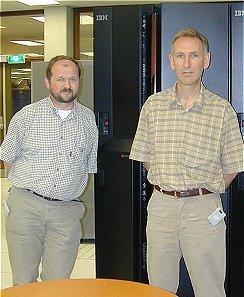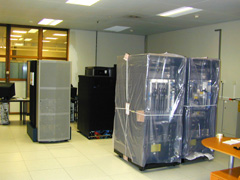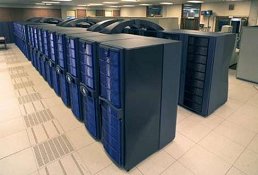S A R A:
H i g h P e r f o r m a n c e C o m p u t i n
g i n t h e N e t h e r l a n d s
By Erik Kluit
July, 2002
SARA,
the High Performance Computing (HPC) Center of the Dutch universities and
research centers, recently acquired six POWER4
Regatta-eServer
pSeries 690
supercomputers. The new machines will mainly be used by the institutes of
the Netherlands
Organization for Scientific Research (NWO), the Vrije
Universiteit (VU) and individual researchers in the area of
Computational Research (natural science and
chemistry simulations). The new Regatta's will deliver around five times
the computational power of the present IBM supercomputer at SARA.
 Wim
Rijks (Systems Manager and Consultant HPC) and Jules Wolfrat (Systems Manager
and Programmer HPC), both specialised in parallelization and
optimalization of software) go a long way with SARA and AIX: before 1990
SARA hosted a 3090 mainframe with six processors, running AIX/370.
Early 90's SARA started using one of the first RS/6000 models: 7013-550
(41 MHz) and three 7013-590's
(66 MHz). Nowadays SARA hosts an SP configuration that consists of three
"towers" or "frames". Two of the frames, used for
batch processing, contain eight so-called "nighthawk-2"
high nodes, each of which contains 16 Power3-II processors (375 MHz), with
1 Gbyte of memory per processor. The third frame, used for interactive
access and job submission, contains 3 "winterhawk-2" wide nodes,
each consisting of 4 Power3-II (375 MHz) processors with 1 Gbyte of memory
per processor. Wim
Rijks (Systems Manager and Consultant HPC) and Jules Wolfrat (Systems Manager
and Programmer HPC), both specialised in parallelization and
optimalization of software) go a long way with SARA and AIX: before 1990
SARA hosted a 3090 mainframe with six processors, running AIX/370.
Early 90's SARA started using one of the first RS/6000 models: 7013-550
(41 MHz) and three 7013-590's
(66 MHz). Nowadays SARA hosts an SP configuration that consists of three
"towers" or "frames". Two of the frames, used for
batch processing, contain eight so-called "nighthawk-2"
high nodes, each of which contains 16 Power3-II processors (375 MHz), with
1 Gbyte of memory per processor. The third frame, used for interactive
access and job submission, contains 3 "winterhawk-2" wide nodes,
each consisting of 4 Power3-II (375 MHz) processors with 1 Gbyte of memory
per processor.
On the picture: Wim Rijks (left) and
Jules Wolfrat in front of one of the Regatta's.
|
|
|
SARA Computing and Networking Services is a
center of expertise in the area of computers and networks, supplying a complete
package of High Performance Computing- and Networking (HPCN) services. |
|

|
|
SARA was founded in 1971 by the Vrije
Universiteit (Free University) in Amsterdam, the University of
Amsterdam and the Mathematical Center.
1985 SARA acquired the status of National High Performance Computing Center and
hosted the Dutch national supercomputer. Apart from this SARA
hosts a number of other supercomputers, some of which in co-ownership with other
universities.
The Dutch universities are important SARA customers, and so are research
institutes and industrial research centers, government and businesses. SARA is
responsible for the operational management of the academic high speed
network of SURFnet.
High Performance Computing (HPC) is technology
that is used to solve problems that are very compute intensive and/or require
processing of huge amounts of data rapidly. Supercomputers are for example used
for fundamental, applied and industrial research in areas like weather
forecasting, climate modeling, computational fluid dynamics, chemistry and
physics. Supercomputers are also used for rendering (high quality visualisation)
of huge amounts of data.
Website: www.sara.nl
|
|
Arrival
of the Regatta's
The Regatta's (eServer
pSeries 690) will be introduced in three
phases. At the beginning of January 2002 the first two arrived. Each of  these Regatta's contains one node with 32
Power4-processors, with a clock cycle of 1,1 GHz. This adds 280
GFlop/s
in one blow to the existing peak performance of 210 GFlop/s, more than
doubling the capacity of the system. Each node contains 32 Gbyte of shared
memory. Each tower has a local scratch
space of 135 Gbyte. The home file systems are mounted from an external file
server, just like on the 'old' SP systems.
these Regatta's contains one node with 32
Power4-processors, with a clock cycle of 1,1 GHz. This adds 280
GFlop/s
in one blow to the existing peak performance of 210 GFlop/s, more than
doubling the capacity of the system. Each node contains 32 Gbyte of shared
memory. Each tower has a local scratch
space of 135 Gbyte. The home file systems are mounted from an external file
server, just like on the 'old' SP systems.
However, the new towers are not
yet
connected to the fast switch (SP Switch2), which means that the General
Parallel File System (GPFS) is not
available yet. GPFS is designed to provide high performance by
"striping" I/O across multiple disks and high scalability (by
utilizing multiple servers) through the SP Switch2.
Wim Rijks and Jules Wolfrat point out that the
performance of the GPFS file system becomes more and more a bottleneck, it
can't keep up with the speed of the other resources (processors and
memory-access).
For connectivity to the outside world and to the Regatta servers Gigabit-Ethernet
is available.
By the end of 2002 the next two Regatta's and the fast switch will be
installed, replacing the "nighthawk-2" high nodes. With the installation of the last two machines in 2004 the
configuration will consist of 204 processors (six Regatta's and the
"winterhawk-2" wide nodes), 204 GB RAM and around 1
TFlop/s of computational power.
The
Top 10 Supercomputer Sites of June 2002 (www.top500.org)
for comparison:
| Rank |
Manufacturer |
Computer |
#
Proc |
Rmax
(TFlops) |
Installation
Site |
Year |
| 1 |
NEC |
Earth-Simulator |
5120 |
35.86 |
Earth
Simulator Center Yokohama, Japan |
2002 |
| 2 |
IBM |
ASCI White, SP
Power3 375 MHz |
8192 |
7.22 |
Lawrence
Livermore National Laboratory Livermore, USA |
2000 |
| 3 |
Hewlett-
Packard |
AlphaServer SC
ES45/1 GHz |
3016 |
4.46 |
Pittsburgh
Supercomputing Center Pittsburgh, USA |
2001 |
| 4 |
Hewlett-
Packard |
AlphaServer SC
ES45/1 GHz |
2560 |
3.98 |
Commissariat
a l'Energie Atomique (CEA) Bruyeres-le-Chatel, France |
2001 |
| 5 |
IBM |
SP Power3 375 MHz 16
way |
3328 |
3.05 |
NERSC/LBNL
Berkeley, USA |
2001 |
| 6 |
Hewlett-
Packard |
AlphaServer SC
ES45/1 GHz |
2048 |
2.91 |
Los
Alamos National Laboratory Los Alamos, USA |
2002 |
| 7 |
Intel |
ASCI Red |
9632 |
2.37 |
Sandia
National Laboratories Albuquerque, USA |
1999 |
| 8 |
IBM |
pSeries 690 Turbo
1.3GHz |
864 |
2.31 |
Oak
Ridge National Laboratory Oak Ridge, USA |
2002 |
| 9 |
IBM |
ASCI Blue-Pacific
SST, IBM SP 604e |
5808 |
2.14 |
Lawrence
Livermore National Laboratory Livermore, USA |
1999 |
| 10 |
IBM |
pSeries 690 Turbo
1.3GHz |
768 |
2.00 |
IBM/US Army Research
Laboratory (ARL) Poughkeepsie, USA |
2002 |
Keep it dry !
 I
was also invited to take a look on the computer-floor. Computers don't use space
these days, true, but a lot of computers do! I was impressed by the size of the Dutch national supercomputer:
a 1024-CPU system consisting of two 512-CPU SGI
Origin 3800 systems (picture). The machine is fitted with 500MHz R14000 CPUs organized
in 256 4-CPU nodes, and has a peak performance of 1 TFlop/s.
I
was also invited to take a look on the computer-floor. Computers don't use space
these days, true, but a lot of computers do! I was impressed by the size of the Dutch national supercomputer:
a 1024-CPU system consisting of two 512-CPU SGI
Origin 3800 systems (picture). The machine is fitted with 500MHz R14000 CPUs organized
in 256 4-CPU nodes, and has a peak performance of 1 TFlop/s.
Other systems SARA hosts are a CRAY Origin2000 (parallel system), an SGI Onyx2
RealityMonster (grafical system) and three Beowulf clusters (parallel systems).
Several systems at SARA are in the Top500
list of supercomputers.
While we walk down the stairs Wim Rijks explains why the computers are on the
first floor: water! In case of a flood (remember we are in the Netherlands here,
dikes can break) the computers keep it dry!
Parallelization of Programs
Parallel computer architectures are common in the world of supercomputers. SARA
has the necessary skills to adapt or build computer programs to these parallel
architectures: analyzing the opportunities for parallelization, choosing the
parallelization method, optimizing the serial version of the program and
parallelizing the program. On the website of SARA you can find a list of finished Parallel
projects. Most of the projects done were funded by NCF
(the Dutch National Foundation for Computerfacilities). NCF is responsible for
the HPC infrastucture for scientific research in the Netherlands.
The Regatta's are best suited for programs that make use of parallelization
(using up-to 32 processors with shared memory) in
combination with high processing power needs.
The SP configuration uses OpenMP for running shared-memory parallel programs
(C/C++ and Fortran) on one node.
OpenMP is a
portable, scalable model that gives shared-memory parallel programmers a simple
and flexible interface for developing parallel applications.
On the SP it is possible to run parallel programs involving either up to
eight 16-CPU nodes or two 32-CPU nodes. However, these programs have to be
parallelized with MPI. It is also possible to combine MPI with OpenMP compiler
directives. Technically it is possible to run a parallel job involving all of
the SP's nodes but the current setup of the batch system does not support this.
MPI is an international accepted standard for a
message passing library, for use in C en Fortran programs, and designed for high
performance on both massively parallel machines and on workstation clusters.
One of the main users, the Department of Theoretical Chemistry
(VU Research Group), will use the Regatta's to run
chemistry simulations using the Amsterdam
Density Functional software package (ADF) that
uses MPI.
 Wim
Rijks (Systems Manager and Consultant HPC) and Jules Wolfrat (Systems Manager
and Programmer HPC), both specialised in parallelization and
optimalization of software) go a long way with SARA and AIX: before 1990
SARA hosted a 3090 mainframe with six processors, running AIX/370.
Early 90's SARA started using one of the first RS/6000 models: 7013-550
(41 MHz) and three 7013-590's
(66 MHz). Nowadays SARA hosts an SP configuration that consists of three
"towers" or "frames". Two of the frames, used for
batch processing, contain eight so-called "nighthawk-2"
high nodes, each of which contains 16 Power3-II processors (375 MHz), with
1 Gbyte of memory per processor. The third frame, used for interactive
access and job submission, contains 3 "winterhawk-2" wide nodes,
each consisting of 4 Power3-II (375 MHz) processors with 1 Gbyte of memory
per processor.
Wim
Rijks (Systems Manager and Consultant HPC) and Jules Wolfrat (Systems Manager
and Programmer HPC), both specialised in parallelization and
optimalization of software) go a long way with SARA and AIX: before 1990
SARA hosted a 3090 mainframe with six processors, running AIX/370.
Early 90's SARA started using one of the first RS/6000 models: 7013-550
(41 MHz) and three 7013-590's
(66 MHz). Nowadays SARA hosts an SP configuration that consists of three
"towers" or "frames". Two of the frames, used for
batch processing, contain eight so-called "nighthawk-2"
high nodes, each of which contains 16 Power3-II processors (375 MHz), with
1 Gbyte of memory per processor. The third frame, used for interactive
access and job submission, contains 3 "winterhawk-2" wide nodes,
each consisting of 4 Power3-II (375 MHz) processors with 1 Gbyte of memory
per processor.
 these Regatta's contains one node with 32
Power4-processors, with a clock cycle of 1,1 GHz. This adds 280
GFlop/s
in one blow to the existing peak performance of 210 GFlop/s, more than
doubling the capacity of the system. Each node contains 32 Gbyte of shared
memory. Each tower has a local scratch
space of 135 Gbyte. The home file systems are mounted from an external file
server, just like on the 'old' SP systems.
these Regatta's contains one node with 32
Power4-processors, with a clock cycle of 1,1 GHz. This adds 280
GFlop/s
in one blow to the existing peak performance of 210 GFlop/s, more than
doubling the capacity of the system. Each node contains 32 Gbyte of shared
memory. Each tower has a local scratch
space of 135 Gbyte. The home file systems are mounted from an external file
server, just like on the 'old' SP systems.  I
was also invited to take a look on the computer-floor. Computers don't use space
these days, true, but a lot of computers do! I was impressed by the size of the Dutch national supercomputer:
a 1024-CPU system consisting of two 512-CPU
I
was also invited to take a look on the computer-floor. Computers don't use space
these days, true, but a lot of computers do! I was impressed by the size of the Dutch national supercomputer:
a 1024-CPU system consisting of two 512-CPU